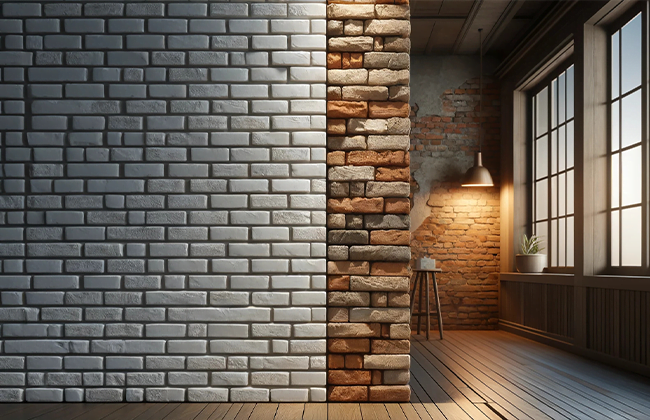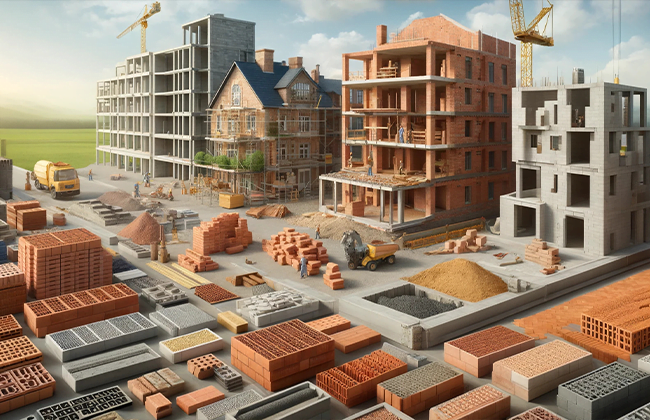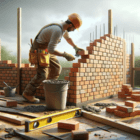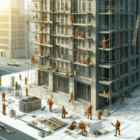When planning any construction or renovation project, understanding the various types of bricks is crucial. Bricks are not only fundamental for the structural integrity of a building but also for its aesthetic appearance. Each type of brick offers different benefits, from durability and strength to environmental friendliness and aesthetic appeal. This guide will explore the key characteristics and uses of the different types of bricks to help you make an informed choice for your next project.
Table of Contents
What Are Bricks?
Bricks are fundamental building materials in construction, typically formed into small rectangular blocks. Manufacturers primarily make bricks from fired or sun-dried clay, but they can also craft them from concrete and other composite materials. Their historical significance in architecture arises from their inherent durability, robust strength, and ability to resist weathering, fire, and erosion. As essential components of construction, bricks have evolved in types and uses to meet diverse architectural demands.
Types of Bricks
The choice of brick can significantly impact both the structural integrity and aesthetic appeal of a building. Below, we dive into the details of the various types available, each suited for specific construction needs:
1. Burnt Clay Bricks
Burnt clay bricks are the benchmark in brick construction, renowned for their robustness and durability. These bricks are produced by pressing wet clay into molds, which are then dried and fired in a kiln at high temperatures. This process enhances their final hardness and strength, making them ideal for a variety of structural applications including building robust foundations and creating aesthetically pleasing pavements.
- First Class Bricks: Known for their superior quality, these bricks feature a smooth texture and uniform shape, making them perfect for visible parts of a building where aesthetic appeal is crucial. Their sharp, clean edges and even surfaces make them a popular choice for facades.
- Second Class Bricks: Although these bricks may have slight irregularities in shape and size, they still offer considerable strength and durability. They are commonly employed in parts of a building that are not exposed, like under plaster or inside wall cavities.
- Third Class Bricks: Builders use these bricks, characterized by their rough texture and irregular shape, in non-permanent structures or applications where the finish is not a priority, as they are typically less durable.
- Fourth Class Bricks: Builders often crush and repurpose these over-burnt, brittle bricks as aggregate in concrete, significantly contributing to the material’s overall strength and stability
2. Concrete Bricks
Builders prize concrete bricks, made from solid concrete, for their aesthetic flexibility and uniformity, making them a prime choice for modern architectural designs. They extensively utilize these bricks in constructing fences and facade panels, thanks to their ability to be manufactured in various colors and finishes. This versatility allows architects and designers to achieve specific visual outcomes, enhancing the modern appeal of constructions.
3. Sand Lime Bricks
Manufacturers produce sand lime bricks, also known as calcium silicate bricks, from a mixture of sand, lime, and fly ash, which they chemically process and then mold under pressure. They subsequently cure these bricks in a steam autoclave, resulting in a strong and smooth surface. Their fine texture makes them particularly suitable for applications requiring a painted or stucco finish, providing an excellent base for such decorative treatments.
4. Engineering Bricks
Engineers value engineering bricks for their exceptional compressive strength and low porosity, which make them particularly suitable for structures exposed to severe environmental conditions or substantial loads. They often use these bricks in critical civil engineering projects like sewers and retaining walls, where enduring strength and durability are paramount.
5. Fly Ash Clay Bricks
Manufacturers make an environmentally friendly choice with fly ash clay bricks by combining fly ash—a byproduct of coal combustion in power plants—with clay. Manufacturers recognize these bricks for their excellent thermal and fire insulation properties and typically fire them at about 1,000 degrees Celsius, resulting in a robust and sustainable building material.
6. Fire Bricks (Refractory Bricks)
Designed to withstand extremely high temperatures, fire bricks or refractory bricks are crucial for lining furnaces, kilns, and fireplaces. These bricks are made from fire clay and are composed to perform well under extreme heat, thus protecting structural integrity in high-temperature environments.
7. Decorative Bricks
Decorative bricks serve not only for their structural capabilities but also for their aesthetic qualities. Builders often use these bricks in wall veneers and feature walls, crafting them from various materials and incorporating unique textures and colors to enhance the visual appeal of both interior and exterior designs.
8. Recycled Bricks
Recycled bricks, reclaimed from demolished structures, are cleaned and reused in new construction projects. They are a popular choice in sustainable building practices, offering unique aesthetic qualities and a reduced environmental footprint.
Understanding the diverse types of bricks helps architects, builders, and homeowners make informed decisions that balance functionality, aesthetics, and environmental considerations. Each type of brick serves a specific purpose, from ensuring structural integrity to enhancing decorative appeal, meeting every construction need with the right material.
Specialized Bricks
Specialized bricks are designed for specific, often demanding, construction needs. Their unique properties make them ideal for applications where standard bricks might not provide the necessary performance. Here, we’ll explore two primary types of specialized bricks: Engineering Bricks and Fire Bricks.
Engineering Bricks
Engineers highly prize engineering bricks for their exceptional compressive strength and low water absorption rates, making them perfect for use in environments that demand durability and resistance to moisture. These bricks are a fundamental element in many civil engineering projects, where their properties can significantly influence the longevity and safety of structures.
- Applications: Builders typically use engineering bricks in projects that require robust, moisture-resistant materials. You will commonly find them in the construction of sewers, manholes, and retaining walls. Their ability to withstand aggressive environmental conditions also makes them suitable for foundations and below-ground works where high levels of dampness are anticipated.
- Benefits: The primary advantage of engineering bricks lies in their strength and durability, which are crucial for structural integrity in challenging environments. Moreover, their low porosity protects against frost damage and chemical erosion, further enhancing their suitability for outdoor and industrial applications.
Fire Bricks (Refractory Bricks)
Manufacturers design fire bricks, or refractory bricks, to withstand very high temperatures, making them essential for use in kilns, furnaces, and fireplaces. They make these bricks from fire clay, which has a higher heat resistance than most other brick materials, ensuring performance in extreme conditions.
- Composition: Fire bricks are composed of fire clay, alumina, and silica, which give them their ability to cope with high temperatures. The exact composition can vary based on the intended use and temperature requirements.
- Applications: Manufacturers primarily use these bricks to line the interiors of kilns and furnaces, where intense heat would damage regular bricks. Builders also use them in constructing fireboxes and fireplaces, where direct exposure to flames is common.
- Benefits: The key benefit of fire bricks is their thermal stability. They can withstand temperature extremes without melting or cracking, which is essential for the safety and efficiency of high-temperature operations. Additionally, fire bricks help in heat retention, improving energy efficiency in heating systems.
By incorporating these specialized bricks into appropriate projects, architects and builders can ensure that each construction element performs optimally under its specific conditions. Whether it’s bearing the load of a heavy structure or resisting high temperatures in an industrial furnace, specialized bricks are key to achieving both safety and functionality in challenging environments.
Aesthetic Varieties

Manufacturers specially design aesthetic varieties of bricks to enhance the visual appeal of structures, focusing on the decorative aspects without compromising structural integrity. Builders commonly use these types of bricks in projects where appearance is as important as functionality. Below, we explore two popular aesthetic varieties: Facing Bricks and Exposed Brickwork.
Facing Bricks
Manufacturers primarily use facing bricks for their aesthetic qualities on exterior walls. They design these bricks with a special focus on color, texture, and size, ensuring that each brick not only performs well but also contributes to the visual appeal of the building.
- Applications: These bricks are typically seen on the exterior faces of buildings, where the visual impact is critical. Whether for residential homes or commercial buildings, facing bricks provide a durable and attractive facade that can withstand the elements.
- Benefits: Besides their beauty, manufacturers treat facing bricks to be weather-resistant, helping to maintain their color and texture against harsh weather conditions. This treatment ensures that the buildings not only look good but also receive protection from environmental factors like rain, frost, and sun exposure.
Exposed Brickwork
Exposed brickwork is a style that has gained popularity for its rustic and industrial charm. It involves leaving the brickwork visible within interior spaces, showcasing the natural beauty of the brick itself.
- Applications: Architects and designers commonly use this approach in lofts, cafes, and modern offices, where the aesthetic of raw materials adds unique character to the space. They can use exposed brickwork as a feature wall or as part of the overall interior design theme.
- Benefits: The main appeal of exposed brickwork lies in its aesthetic versatility. It can complement various decor styles, from modern to traditional. Additionally, exposed brickwork adds texture and depth to interiors, creating a focal point that draws the eye and enhances the overall design.
Both facing bricks and exposed brickwork serve specific purposes in construction and design. They offer solutions that meet the needs of projects aiming for aesthetic appeal. By choosing the right type of brick for your project, you can ensure that your building not only stands strong but also looks stunning. Whether you’re aiming for a sleek, modern look with facing bricks or a more textured, rustic appeal with exposed brickwork. These materials offer the flexibility to achieve your design vision while providing lasting durability.
Environmental and Recycled Options
As the construction industry moves towards more sustainable practices, the use of environmentally friendly materials has become increasingly important. Among these, recycled bricks stand out as a prime example of sustainability in building materials. Below, we explore the concept of recycled bricks and their benefits in modern construction.
Recycled Bricks
Recycled bricks are bricks that have been reclaimed from demolished structures and then cleaned and processed for reuse in new building projects. This approach not only helps reduce waste but also conserves the natural resources required to produce new bricks.
- Sources: Older buildings undergoing demolition typically provide these bricks. This allows for the preservation and reuse of materials with historical value and aesthetic appeal instead of discarding them.
- Process: The recovery process involves carefully dismantling brick structures. It includes cleaning the bricks of mortar and impurities, and then grading them according to size, color, and strength. This ensures that only bricks that meet structural safety standards are reused.
- Applications: Recycled bricks are used in a variety of construction projects, including new buildings, renovations, and landscape designs. They are particularly popular in projects aiming for a rustic or vintage aesthetic. The aged look of the bricks adds character and charm.
- Benefits: The environmental impact of using recycled bricks is significantly lower compared to manufacturing new ones. It reduces the demand for raw materials, lowers energy consumption in brick production, and decreases landfill waste. Additionally, recycled bricks can contribute to the building’s sustainability credentials, such as LEED certification. This makes them a favored choice among eco-conscious builders and architects.
Recycled bricks offer a unique combination of environmental benefits, aesthetic appeal, and historical significance. This makes them a valuable choice for sustainable construction. By incorporating these bricks into projects, builders and developers can contribute to a more sustainable future. They can also enjoy the distinct look and feel that only recycled materials can provide. Whether used in a new construction or a restoration project, recycled bricks allow for creativity and sustainability to go hand in hand.
Choosing the Right Type of Brick
Selecting the appropriate type of brick for a construction project is crucial for ensuring both the structural integrity and aesthetic quality of the building. The choice of brick can influence not only the durability and safety of the structure. It also affects its visual appeal and environmental impact. Let’s delve into the factors that should guide this important decision.
Factors to Consider
- Strength Requirements: The paramount strength of the brick is crucial, especially in structures that bear significant loads or face harsh environmental conditions. Engineering bricks, known for their high compressive strength, are often the go-to choice for such demanding applications.
- Aesthetic Considerations: For projects where visual appearance is a key element, the color and texture of the bricks are significant. Facing bricks come in various colors and textures, offering designers the flexibility to match or enhance the building’s design theme.
- Environmental Conditions: The local climate and environmental conditions are critical factors in choosing the right type of brick. For example, in areas with high moisture levels, bricks with low water absorption rates are preferable. Engineering bricks help prevent water damage and maintain structural integrity.
- Size and Dimensional Stability: The size of the bricks can affect the speed of construction and the overall aesthetics of the building. Larger bricks can lead to faster construction times but may not offer the same traditional appearance as smaller, standard-sized bricks. Additionally, ensuring that the bricks chosen have good dimensional stability will reduce maintenance issues over time.
- Environmental Impact: For projects aiming to be environmentally friendly, considering the life cycle and sustainability of the brick is essential. Recycled bricks are an excellent choice for reducing the environmental footprint of a construction project. They reuse existing materials and reduce waste.
Making the Decision
When choosing the right type of brick, it’s beneficial to consult with architects, structural engineers, and other construction professionals. They can provide insights based on the specific needs of the project. Sampling different types of bricks and conducting tests, if necessary, can also help in making an informed choice.
By carefully considering these factors, builders and designers can select the most appropriate type of brick. This ensures it meets the structural requirements, complements the design aesthetics, and aligns with environmental sustainability goals. This thoughtful selection process ensures that the finished building will stand the test of time, both structurally and visually.
Conclusion
Choosing the right types of bricks is vital for any construction project. It impacts everything from the building’s structural integrity to its environmental impact and aesthetic appeal. If you’re looking for professional guidance on types of bricks for brick pointing, don’t hesitate to reach out to a seasoned contractor. For expert advice, you can contact (+1) 917-355-8556 to discuss your specific needs. This ensures your project’s success with the best materials available.
FAQs
Q: What are the most common types of bricks used in residential construction?
A: The most common types of bricks used in residential buildings include burnt clay bricks and sand lime bricks. They are known for their strength and aesthetic versatility.
Q: How do I choose the right type of bricks for high moisture areas?
A: For high moisture areas, choosing types of bricks like engineering bricks is ideal. They have low water absorption and high durability.
Q: Can the types of bricks affect the thermal efficiency of a building?
A: Absolutely, the types of bricks you choose can impact a building’s thermal efficiency. For example, fly ash clay bricks are known for their excellent insulation properties.
Q: Are there environmentally friendly types of bricks?
A: Yes, recycled bricks stand out among the eco-friendly types of bricks. They reduce waste and conserve natural resources by reusing materials from demolished structures.
Q: What types of bricks are best for adding aesthetic value to my home?
A: Decorative and facing types of bricks are perfect for enhancing the visual appeal of your home. They offer a variety of textures and colors.




